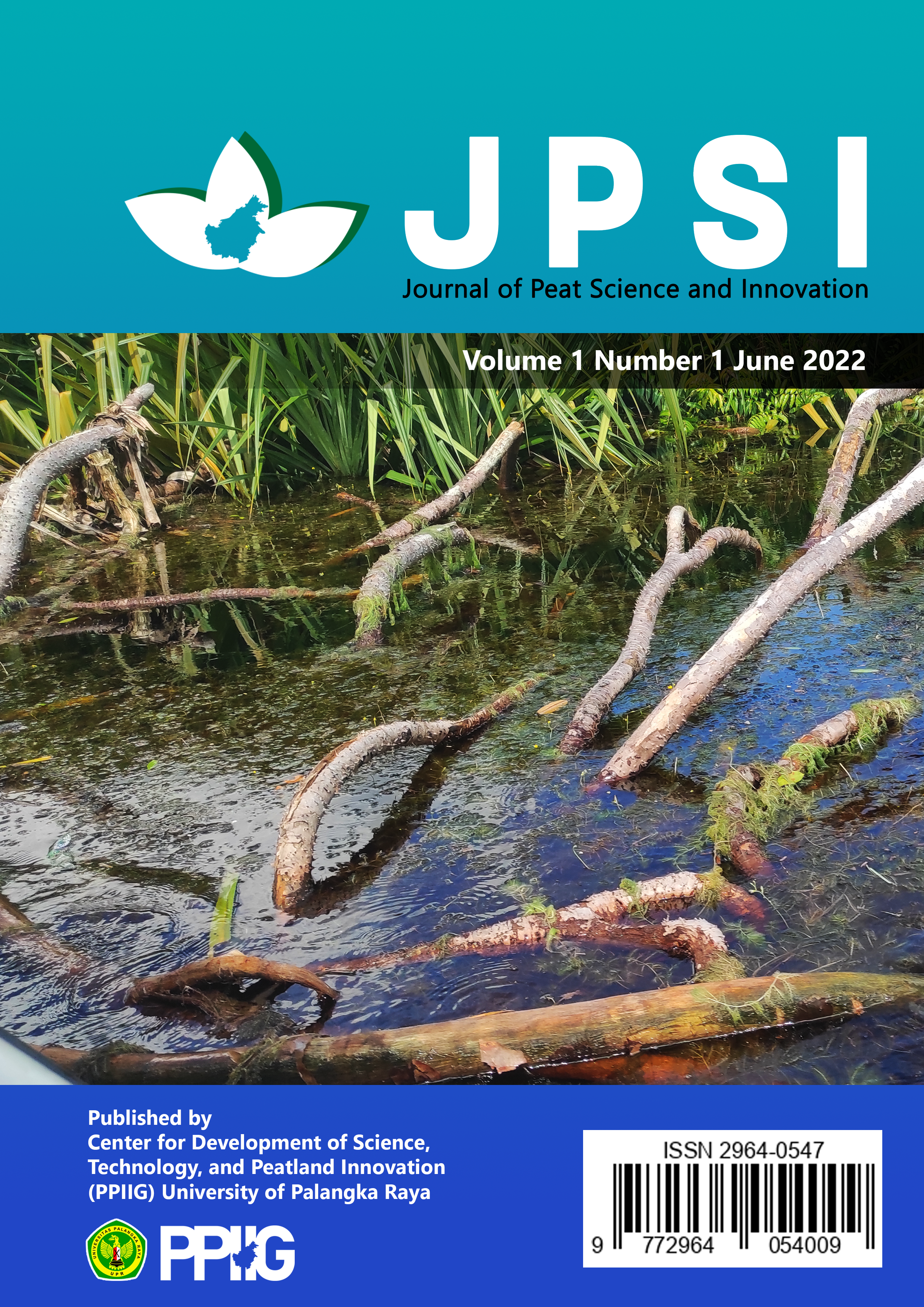Preliminary Exploration of Cyanobacteria in Peat Waters, Palangka Raya, Central Kalimantan, Indonesia
DOI:
https://doi.org/10.59032/jpsi.v1i1.7559Keywords:
Blue-Green Algae, Cyanobacteria, Microalgae, Peat Waters, PhytoplanktonAbstract
Cyanobacteria were formerly known as blue-green algae and are currently considered algae-like Gram-negative bacteria belonging to the bacterial kingdom. Lack of scientific information on the presence and distribution of cyanobacteria species in peat water habitats, particularly in Central Kalimantan, Indonesia, which has extensive peat waters. This study aims to conduct a preliminary exploration as an initial action for further research on the diversity and distribution of cyanobacteria species in peat water ecosystems. The results of the study reported that 5 species of cyanobacteria were found to be present in the peat water habitat in Palangka Raya, Central Kalimantan, Indonesia, belonging to the orders Chroococcales, Oscillatoriales, and Synechococcales. The cyanobacteria species found in this study include Microcystis sp., Chroococcus sp., Oscillatoria sp., Arthrospira sp., and Pseudanabaena sp. These findings indicate that further research needs to be carried out to explore, identify and isolate cyanobacteria from peat waters to obtain more detailed and clear data as a basis for optimizing the potential and benefits of cyanobacteria for sustainable life.
Downloads
References
Adam, C. (2022). Variety of Cell Size of Cosmarium spp. And Euastrum spp. (Desmidiaceae, Charophyte) from the Aquatic Environment around Palangka Raya, Central Kalimantan, Indonesia. Jurnal Biota, 8(1), 1–10. https://doi.org/10.19109/Biota.v8i1.8002
Borowitzka, M. A. (2018). Chapter 3—Biology of Microalgae. In I. A. Levine & J. Fleurence (Eds.), Microalgae in Health and Disease Prevention (pp. 23–72). Academic Press. https://doi.org/10.1016/B978-0-12-811405-6.00003-7
Catherine, Q., Susanna, W., Isidora, E.-S., Mark, H., Aurélie, V., & Jean-François, H. (2013). A review of current knowledge on toxic benthic freshwater cyanobacteria—Ecology, toxin production and risk management. Water Research, 47(15), 5464–5479. https://doi.org/10.1016/j.watres.2013.06.042
Chaiyasitdhi, A., Miphonpanyatawichok, W., Riehle, M. O., Phatthanakun, R., Surareungchai, W., Kundhikanjana, W., & Kuntanawat, P. (2018). The biomechanical role of overall-shape transformation in a primitive multicellular organism: A case study of dimorphism in the filamentous cyanobacterium Arthrospira platensis. PloS One, 13(5), e0196383. https://doi.org/10.1371/journal.pone.0196383
Cymbaluk, N. F. (2013). 4—Water. In R. J. Geor, P. A. Harris, & M. Coenen (Eds.), Equine Applied and Clinical Nutrition (pp. 80–95). W.B. Saunders. https://doi.org/10.1016/B978-0-7020-3422-0.00004-3
Dodd, J. D. (1960). Filament Movement in Oscillatoria sancta (Kuetz.) Gomont. Transactions of the American Microscopical Society, 79(4), 480–485. JSTOR. https://doi.org/10.2307/3224133
D’ors, A., Bartolomé, M. C., & Sánchez-Fortún, S. (2013). Toxic risk associated with sporadic occurrences of Microcystis aeruginosa blooms from tidal rivers in marine and estuarine ecosystems and its impact on Artemia franciscana nauplii populations. Chemosphere, 90(7), 2187–2192. https://doi.org/10.1016/j.chemosphere.2012.11.029
Gao, J., Zhu, J., Wang, M., & Dong, W. (2018). Dominance and Growth Factors of Pseudanabaena sp. In Drinking Water Source Reservoirs, Southern China. Sustainability, 10(11), 3936. https://doi.org/10.3390/su10113936
Gaysina, L. A., Saraf, A., & Singh, P. (2019). Chapter 1—Cyanobacteria in Diverse Habitats. In A. K. Mishra, D. N. Tiwari, & A. N. Rai (Eds.), Cyanobacteria (pp. 1–28). Academic Press. https://doi.org/10.1016/B978-0-12-814667-5.00001-5
Guiry, M. D., & Guiry, G. M. (2022). AlgaeBase. World-wide electronic publication. National University of Ireland, Galway. Algaebase. http://www.algaebase.org; searched on 24 July 2022
Gupta, S., & Agrawal, S. C. (2006). Motility in Oscillatoria salina as affected by different factors. Folia Microbiologica, 51(6), 565–571. https://doi.org/10.1007/BF02931621
Halfen, L. N., & Castenholz, R. W. (1971). Gliding Motility in the Blue-Green Alga Oscillatoria Princeps. Journal of Phycology, 7(2), 133–145. https://doi.org/10.1111/j.1529-8817.1971.tb01492.x
Heisler, J., Glibert, P., Burkholder, J., Anderson, D., Cochlan, W., Dennison, W., Gobler, C., Dortch, Q., Heil, C., Humphries, E., Lewitus, A., Magnien, R., Marshall, H., Sellner, K., Stockwell, D., Stoecker, D., & Suddleson, M. (2008). Eutrophication and Harmful Algal Blooms: A Scientific Consensus. Harmful Algae, 8(1), 3–13. https://doi.org/10.1016/j.hal.2008.08.006
Ho, J.-N., Watson, R. R., & Lee, J. (2013). Chapter 11—Dietary Supplements, Immune Modulation, and Diabetes Control. In R. R. Watson & V. R. Preedy (Eds.), Bioactive Food as Dietary Interventions for Diabetes (pp. 111–120). Academic Press. https://doi.org/10.1016/B978-0-12-397153-1.00011-1
Khandual, S., Sanchez, E. O. L., Andrews, H. E., & de la Rosa, J. D. P. (2021). Phycocyanin content and nutritional profile of Arthrospira platensis from Mexico: Efficient extraction process and stability evaluation of phycocyanin. BMC Chemistry, 15(1), 24. https://doi.org/10.1186/s13065-021-00746-1
Komárek, J., & Johansen, J. R. (2015a). Chapter 3—Coccoid Cyanobacteria. In J. D. Wehr, R. G. Sheath, & J. P. Kociolek (Eds.), Freshwater Algae of North America (Second Edition) (pp. 75–133). Academic Press. https://doi.org/10.1016/B978-0-12-385876-4.00003-7
Komárek, J., & Johansen, J. R. (2015b). Chapter 4—Filamentous Cyanobacteria. In J. D. Wehr, R. G. Sheath, & J. P. Kociolek (Eds.), Freshwater Algae of North America (Second Edition) (pp. 135–235). Academic Press. https://doi.org/10.1016/B978-0-12-385876-4.00004-9
Leak, L. V. (1967). Fine structure of the mucilaginous sheath of Anabaena sp. Journal of Ultrastructure Research, 21(1), 61–74. https://doi.org/10.1016/S0022-5320(67)80006-6
Lee, E. H., Park, J.-E., Choi, Y.-J., Huh, K.-B., & Kim, W.-Y. (2008). A randomized study to establish the effects of spirulina in type 2 diabetes mellitus patients. Nutrition Research and Practice, 2(4), 295–300. https://doi.org/10.4162/nrp.2008.2.4.295
Lee, H., Depuydt, S., Choi, S., Kim, G., Kim, Y., Pandey, L. K., Häder, D.-P., Han, T., & Park, J. (2021). Chapter 10—Potential use of nuisance cyanobacteria as a source of anticancer agents. In R. p. Sinha & D.-P. Häder (Eds.), Natural Bioactive Compounds (pp. 203–231). Academic Press. https://doi.org/10.1016/B978-0-12-820655-3.00010-0
Lee, R. E. (2008). Phycology (4th ed.). Cambridge University Press, Cambridge.
Masojídek, J., & Torzillo, G. (2014). Mass Cultivation of Freshwater Microalgae☆. In Reference Module in Earth Systems and Environmental Sciences. Elsevier. https://doi.org/10.1016/B978-0-12-409548-9.09373-8
McLellan, N. L., & Manderville, R. A. (2017). Toxic mechanisms of microcystins in mammals. Toxicology Research, 6(4), 391–405. https://doi.org/10.1039/c7tx00043j
Michalak, I., Mironiuk, M., Godlewska, K., Trynda, J., & Marycz, K. (2020). Arthrospira (Spirulina) platensis: An effective biosorbent for nutrients. Process Biochemistry, 88, 129–137. https://doi.org/10.1016/j.procbio.2019.10.004
Nicoletti, M. (2022). Chapter 10—The nutraceutical potential of cyanobacteria. In G. Lopes, M. Silva, & V. Vasconcelos (Eds.), The Pharmacological Potential of Cyanobacteria (pp. 287–330). Academic Press. https://doi.org/10.1016/B978-0-12-821491-6.00010-7
Nienaber, M. A., & Steinitz-Kannan, M. (2018). A Guide to Cyanobacteria. University Press of Kentucky; JSTOR. https://doi.org/10.2307/j.ctv8j70z
Percival, S. L., & Williams, D. W. (2014). Chapter Five—Cyanobacteria. In S. L. Percival, M. V. Yates, D. W. Williams, R. M. Chalmers, & N. F. Gray (Eds.), Microbiology of Waterborne Diseases (Second Edition) (pp. 79–88). Academic Press. https://doi.org/10.1016/B978-0-12-415846-7.00005-6
Qu, J., Shen, L., Zhao, M., Li, W., Jia, C., Zhu, H., & Zhang, Q. (2018). Determination of the Role of Microcystis aeruginosa in Toxin Generation Based on Phosphoproteomic Profiles. Toxins, 10(7). https://doi.org/10.3390/toxins10070304
Ranković, B., & Kosanić, M. (2021). Chapter 12—Biotechnological substances in lichens. In R. p. Sinha & D.-P. Häder (Eds.), Natural Bioactive Compounds (pp. 249–265). Academic Press. https://doi.org/10.1016/B978-0-12-820655-3.00012-4
Rosen, B. H., & St. Amand, A. (2015). Field and laboratory guide to freshwater cyanobacteria harmful algal blooms for Native American and Alaska Native communities (Report No. 2015–1164; Open-File Report, p. 54). USGS Publications Warehouse. https://doi.org/10.3133/ofr20151164
Sand-Jensen, K. (2014). Ecophysiology of gelatinous Nostoc colonies: Unprecedented slow growth and survival in resource-poor and harsh environments. Annals of Botany, 114(1), 17–33. https://doi.org/10.1093/aob/mcu085
Sarkar, S., Sarkar, S., Manna, M. S., Gayen, K., & Bhowmick, T. K. (2022). Chapter 12—Extraction of carbohydrates and proteins from algal resources using supercritical and subcritical fluids for high-quality products. In M. Garcia-Vaquero & G. Rajauria (Eds.), Innovative and Emerging Technologies in the Bio-marine Food Sector (pp. 249–275). Academic Press. https://doi.org/10.1016/B978-0-12-820096-4.00008-0
Seghiri, R., Kharbach, M., & Essamri, A. (2019). Functional Composition, Nutritional Properties, and Biological Activities of Moroccan Spirulina Microalga. Journal of Food Quality, 2019, 3707219. https://doi.org/10.1155/2019/3707219
Shukla, A., Mongal, D., Mukherjee, G., & Sil, A. K. (2023). Edible Marine Algae: A Wellspring of Bioactive Agents Towards Sustainable Management of Human Welfare. In Reference Module in Food Science. Elsevier. https://doi.org/10.1016/B978-0-12-823960-5.00019-6
Solter, P. F., & Beasley, V. R. (2002). 24—Phycotoxins. In W. M. HASCHEK, C. G. ROUSSEAUX, & M. A. WALLIG (Eds.), Handbook of Toxicologic Pathology (Second Edition) (pp. 631–643). Academic Press. https://doi.org/10.1016/B978-012330215-1/50025-9
Sorokovikova, E. G., Tikhonova, I. V., Belykh, O. I., Klimenkov, I. V., & Likhoshwai, E. V. (2008). Identification of two cyanobacterial strains isolated from the Kotel’nikovskii hot spring of the Baikal rift. Microbiology, 77(3), 365–372. https://doi.org/10.1134/S002626170803017X
Vincent, W. F. (2009). Cyanobacteria. In G. E. Likens (Ed.), Encyclopedia of Inland Waters (pp. 226–232). Academic Press. https://doi.org/10.1016/B978-012370626-3.00127-7
Whitton, B. A. (2012). Ecology of Cyanobacteria II. Their Diversity in Time and Space. Springer Science+Business Media B.V.
Whitton, B. A., & Potts, M. (2002). Introduction to the Cyanobacteria. In B. A. Whitton & M. Potts (Eds.), The Ecology of Cyanobacteria: Their Diversity in Time and Space (pp. 1–11). Springer Netherlands. https://doi.org/10.1007/0-306-46855-7_1
Witty, M. (2009). The Gliding Motion of Oscillatoria and Diatoms. American Society for Microbiology. http://www.microbelibrary.org/library/resources/3182-the-gliding-motion-of-oscillatoria-and-diatoms
Downloads
Published
Versions
- 2023-03-03 (3)
- 2022-11-12 (2)









